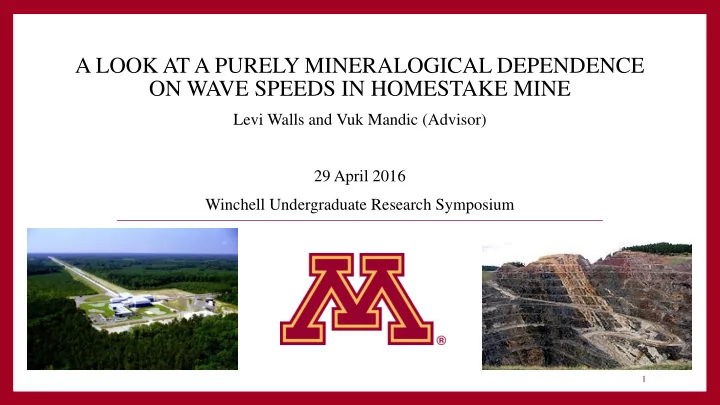

A LOOK AT A PURELY MINERALOGICAL DEPENDENCE ON WAVE SPEEDS IN HOMESTAKE MINE Levi Walls and Vuk Mandic (Advisor) 29 April 2016 Winchell Undergraduate Research Symposium 1
A bit about LIGO • Laser Interferometer Gravitational Wave Observatory (LIGO) works as follows: • Laser → Beams split → Beams travel down arms of identical length → Reflected by mirrors → Beams coincide at beam splitter → Photodetector • If no light output is measured: No signal • If you do measure some light: Possible GW signal (Image courtesy of California Institute of Technology) 2
Motivation • The next generation of LIGO-like GW detectors will likely be built underground (Beker et. al, 2011, General Relativity and Gravitation ) • At very low frequency, seismic noise (SN) dominates. • Seismic waves cause vibrations of test masses and mirrors which could muddle any potential signal. • They can induce other types of noise as well e.g. Newtonian Noise • We will use a 3D array of seismometers to characterize the seismic environment (Beker et. al, 2011, General Relativity and Gravitation ) 3
Homestake Mine, Lead, SD LEFT: We see the seemingly simple structure of three main formations within the Homestake Mine. RIGHT: A generalized cross- section through a particular ledge within the mine; we see that the (overly) simple stratification is not realized. This greatly complicates attempts at determining how seismic waves propagate throughout the mine. (Adapted from Caddey & Geological Survey, 1992) 4
Calculating Elastic Wave Speeds • Main assumption: wave speed through materials is an additive quantity • Using Tables J1, J3, and J5 (Caddey & Geological Survey, 1992) : • Estimate elastic wave speed ( ത 𝑊 𝑁 ) of each site using a normalized weighted average; i.e. ത 𝑊 𝑁 = 𝑥 𝑗 (𝑊 𝑁 ) 𝑗 (1) 𝑗∈𝑇 where 𝑇 spans the sample space consisting of the pertinent minerals in each table, 𝑥 𝑗 is the percent mineral composition, and (𝑊 𝑁 ) 𝑗 is the wave speed of each constituent mineral 5
Results S-wave P-wave 0 2 4 6 8 0 1,000 HPS 2,000 CS HBCS GQSP 3,000 SCQP BQCP Depth (ft) 4,000 GDS SDP 5,000 CQS Quartzite 6,000 QMS SQP 7,000 BQP Amphibolite 8,000 9,000 Wave Speed (km/s) (Boore and Joyner, 1997) 6
A Look at Porosity A look at the porosity of Homestake rocks could give an idea of how the mining and geological history has affected seismic wave propagation. Definition: 𝜚 1−𝜚 ∆𝑢−∆𝑢 𝑛 ∆𝑢 = 𝑊 𝑔 + 𝜚 = or (2) 𝑊 ∆𝑢 𝑔 −∆𝑢 𝑛 𝑛 Where: 1 ∆𝑢 = V p : is the formation transit time (or slowness ) and V p is the formation (P-wave) velocity 1 ∆𝑢 𝑛 = V m : is transit time through the rock matrix 1 ∆𝑢 𝑔 = V f : is the transit time through pore-filling substance (Telford, Geldart, and Sheriff, 1990) 7
Parameters • Recommended: assume water and air as the pore filling substance. • In essence: At these depths, most porosity is water-filled. The exception would be places near where the mine is pumping, but those are only close to drifts. It would be worth doing both. • For water: 𝑛 𝜈𝑡 𝑊 𝑔,𝑥𝑏𝑢𝑓𝑠 ≅ 1,500 𝑡 ⇒ ∆𝑢 𝑔,𝑥𝑏𝑢𝑓𝑠 ≅ 667 𝑛 • For air: 𝑛 𝑡 ⇒ ∆𝑢 𝑔,𝑏𝑗𝑠 ≅ 2.94 ∗ 10 3 𝜈𝑡 𝑊 𝑔,𝑏𝑗𝑠 ≅ 340 𝑛 8
Results: Porosity at the 2000-level Velocity (m/s) LEFT: In calculating the porosity for the 2000-level in the Homestake mine, we see that the porosity for both water- filled (blue points) and Porosity ϕ (%) air-filled (red points) pores is consistent with the literature. In essence: At the 2000-level, the rocks are not very porous. ● ● ● ● ● ● Transit time ( μ s/m) (Adapted from Telford, Geldart, and Sheriff, 1990) 9
Conclusion • Ground-based GW detectors are limited by seismic noise at frequencies below 10 Hz • Moving them underground could limit many noise sources, but a characterization of seismic environment is needed • Calculated seismic wave speeds through Homestake rocks based solely on mineral composition • Model yields wave speeds independent from depth, indicating that any depth-dependence would have to come from porosity and other imperfections in the rock • Porosity calculations were made; we can compare mineral composition model with measurements made at 2000-level 10
Acknowledgements • Thanks go to Vuk Mandic for providing the necessary guidance, shifting this project into reality. • I would also like to thank Gary Pavlis and James Atterholt at Indiana University — Bloomington for providing data at 2000-level in Homestake. 11
References Beker, M., et. al., (2011). Improving the sensitivity of future GW observatories in the 1 – 10 Hz band: Newtonian and seismic noise. General Relativity and Gravitation, 43 (2), 623-656. Boore and Joyner. Site Amplifications for Generic Rock Sites, BSSA, Vol. 87, No.2, pp. 327 – 341, April 1997. Caddey, S., & Geological Survey. (1992). The Homestake Gold Mine : An Early Proterozoic Iron-formation-hosted Gold Deposit, Lawrence County, South Dakota . Print. Carmichael, Robert S. CRC Handbook of Physical Properties of Rocks . v.2. (1982). Print. PetroWiki . 2015. Isotropic elastic properties of minerals. http://petrowiki.org/Isotropic_elastic_properties_of_minerals. (accessed 23 March 2016) Telford, W., Geldart, L., & Sheriff, R. (1990). Applied geophysics (2nd ed.). Cambridge [England] ; New York: Cambridge University Press. 12
Recommend
More recommend